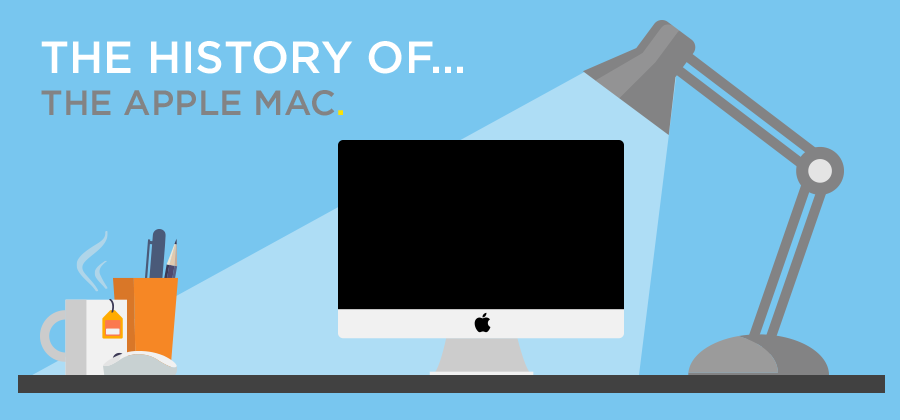

THE HISTORY OF THE APPLE MAC.
Reading TimeWhat is the one piece of equipment that B1 Creative couldn’t function without? Some would say our talent, Mikee would say the kettle, but to be honest, we would be hard-pushed to produce any work for our clients if it wasn’t for the Apple Mac. In what we like to call “The Museum” at B1, we have Mac models dating back as far as 1989, even before B1 came to be.
IT ALL BEGAN WITH AN APPLE… LITERALLY.
But to look at the history of the Apple Mac itself, we’ve had to go back a decade earlier. In 1979, Jef Raskin of Apple Inc began working on a personal computer that would be easy-to-use as well as reasonably priced. This machine was also set to be the first computer on the mass market to have a graphic user interface (or graphic display) and mouse. According to legend, Raskin wanted to name his invention after his favourite type of apple, The McIntosh, but the spelling had to be changed to include an “A” for legal reasons.
Despite Raskin leaving the project in 1981 after an in-company dispute, on 24th January 1984, a nervous Steve Jobs revealed the first Macintosh computer in what he described to his then CEO John Sculley as the most important moment of his life.
But Apple knew they had competition; even in his introductory speech, Jobs jokingly pointed out that they were the “only hope to give IBM a run for its money”, making links between their competitors and George Orwell’s Big Brother of 1984. This was to be the Mac’s biggest selling point, and has remained that way even today. A Macintosh computer didn’t require its user to learn lengthy instructions; “Try the computer you already know how to use” was their advertising strap line.
The Macintosh went on sale with just two applications, MacWrite and MacPaint. By April they had sold 50,000, and an additional 200,000 by the end of the year. Jump forward 34 years and at the end of the first quarter of 2016, that figure now stands at 5.312 million.
BUILDING A FRIENDLY FACE.

The oldest Macintosh in the B1 Creative collection is the Macintosh SE model, manufactured between 1987 and 1990. From the outside, it is pretty similar to the original 1984 machine, despite six models being produced in between. Every early Macintosh model has an ET-like charm, but you’d struggle to say their design was a thing of beauty. Nevertheless in true artistic style, each of the forty-odd people involved with the creation of the 1984 Macintosh inscribed their signatures to the inside rear panel case mould, even though only the engineers would see it. It may seem ironic in hindsight, but the beige colour of the exterior (named PMS 453) was picked specifically because the designer thought it would age well. Despite their now very dated look, these first Macs all have friendly, approachable features, just as Apple intended.
RETURN OF THE MAC.
Over the next few years there was to be much turbulence in the relationship between Jobs and Apple, which lead to his resignation in 1985. Upon leaving Jobs started up a new company NeXT, and also managed to find the time to found a certain animation studio named Pixar. However, following lawsuit after lawsuit, and Apple’s need to buy a modern operating system, NeXT was eventually bought by Apple in 1996, and Jobs was named as “informal adviser” to the then CEO Gil Amelio. In the following months, Amelio was ousted and Jobs slowly moved in to take his place.
By 1998, the Macintosh name had been shortened to “Mac”, a nickname invented by the employees of Apple for the machines. Ken Segall was part of the advertising team responsible for the campaign for the next Mac incarnation
APPLE OF THE “I”.
At this point, Apple were suffering in the market, and whatever happened next was going to be make or break for their future. It was time for another model. They had the “Mac” part, but what next? “MacRocket”, “Macster” were some of the ideas thrown around on the drawing board, but nothing made the grade. “MacMan” came close, as Jobs thought it sounded a bit like Walkman, and had the fun toy-like feel of PacMan, but it wasn’t close enough. Suddenly, it came to Segall that all they needed was a letter. He explained his ideas Jobs:
i for Internet
i for imagination
i for individual
Jobs hated it. But over time, with more alternatives discarded, the i stuck, and so the iMac was born.
Tea and coffee are essential in the B1 Creative studio, but we’d be hard-pushed to produce any work for our clients if it wasn’t for the Apple Mac
The 1998 iMac’s design is dramatically different to Apple’s previous models. The beige was out and colours (or flavours, as Apple referred to them) were in. A translucent, egg-shaped plastic body in thirteen variations (including “Blue Dalmatian”) had a screen that measured 14 inches, not 9 inches as before. This was the first Apple Mac model to get rid of the tower, containing the CPU within the monitor and the floppy disk drive was also replaced, first by tray-loading CD ROM, then the slot-loading. Even the mouse was given a makeover, transforming into a hockey puck style that was later rethought due to impracticality for big hands. Still, the iMac became a huge talking and selling point, and all thanks to Jonathan Ive, the mastermind behind the design (up the Brits!).

LIKE A G4.
After the fun of the G3 came the sleeker, wiser, more grown up iMac G4. This was less ET, and more EVE from Wall-E. It was nicknamed the “iLamp” and the “Sunflower” and connections were made to Luxo Jnr from the Pixar short films (another of Jobs’ babies). The body of the computer was hemispherical, with the screen attached to an adjustable arm, giving it the ability to be moved in just about any angle.
APPLE TODAY.
The iMac G5 followed in 2005, and then the Intel iMac in 2006, first in plastic and then aluminium. This aluminium model has stayed the same up until the present day, only to be updated in terms of software, display quality and screen dimensions. Of course, Apple has been keeping busy outside the desktop market; notebooks, iBooks, MacBooks, iPads, iPods and iPhones have all been through multiple generations, and will no doubt in turn influence many generations of creatives to come.
